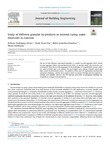Mostrar o rexistro simple do ítem
Study of Different Granular By-Products as Internal Curing Water Reservoirs in Concrete
| dc.contributor.author | Rodríguez-Álvaro, Roberto | |
| dc.contributor.author | Seara Paz, Sindy | |
| dc.contributor.author | González-Fonteboa, Belén | |
| dc.contributor.author | Etxeberria, Miren | |
| dc.date.accessioned | 2022-03-08T19:56:56Z | |
| dc.date.available | 2022-03-08T19:56:56Z | |
| dc.date.issued | 2022 | |
| dc.identifier.citation | Roberto Rodríguez-Álvaro, Sindy Seara-Paz, Belén González-Fonteboa, Miren Etxeberria, Study of different granular by-products as internal curing water reservoirs in concrete, Journal of Building Engineering, Volume 45, 2022, 103623, ISSN 2352-7102, https://doi.org/10.1016/j.jobe.2021.103623. (https://www.sciencedirect.com/science/article/pii/S2352710221014819) | es_ES |
| dc.identifier.uri | http://hdl.handle.net/2183/29919 | |
| dc.description | Financiado para publicación en acceso aberto: Universidade da Coruña/CISUG | es_ES |
| dc.description.abstract | [Abstract] The use of three different waste-based materials, i.e. ceramic recycled aggregate (CRA), mixed recycled aggregate (MRA), and coal bottom ash (CBA), as internal curing water reservoirs was investigated. Their effects as fine aggregates in the mortar phase of a hypothetical concrete with a low water-to-binder ratio were studied. The used binders were ordinary Portland cement and high-volume fly-ash-blended cement. The addition of MRA and CBA significantly decreased the autogenous shrinkage, whereas their negative effects on drying shrinkage and the compressive strength were minimal. However, the CRA had the worst effect on autogenous shrinkage but increased the strength of the specimens. | es_ES |
| dc.description.sponsorship | This work has been carried out within the framework of the HACCURACEM project (BIA2017-85657-R), funded by the Ministry of Economy, Industry and Competitiveness, State Program for Research, Development and Innovation aimed at the challenges of Society, within the framework of the State Plan for Scientific and Technical Research and Innovation 2013–2016, Call 2017. We also thank the Xunta de Galicia (Spain) for the financial support through its pre-doctoral contracts program. Finally, we highlight the collaboration of the companies Votorantim Cimentos and Grupo BASF, for the contribution of some of the materials used in this research | es_ES |
| dc.language.iso | eng | es_ES |
| dc.publisher | Elsevier | es_ES |
| dc.relation | info:eu-repo/grantAgreement/AEI/Plan Estatal de Investigación Científica y Técnica y de Innovación 2013-2016/BIA2017-85657-R/ES/HORMIGONES SOSTENIBLES AUTOCOMPACTANTES DE ALTAS PRESTACIONES MEDIANTE EL USO DE CEMENTOS DE BAJO CONTENIDO EN CLINKER Y AGENTES DE CURADO INTERNO Y AUTSELLADO/ | |
| dc.relation.uri | https://doi.org/10.1016/j.jobe.2021.103623 | es_ES |
| dc.rights | Atribución-NoComercial-SinDerivadas 4.0 Internacional | es_ES |
| dc.rights.uri | http://creativecommons.org/licenses/by-nc-nd/4.0/ | * |
| dc.subject | Internal curing agent | es_ES |
| dc.subject | Residues | es_ES |
| dc.subject | By-product | es_ES |
| dc.subject | Self-desiccation | es_ES |
| dc.subject | Drying | es_ES |
| dc.title | Study of Different Granular By-Products as Internal Curing Water Reservoirs in Concrete | es_ES |
| dc.type | info:eu-repo/semantics/article | es_ES |
| dc.rights.access | info:eu-repo/semantics/openAccess | es_ES |
| UDC.journalTitle | Journal of Building Engineering | es_ES |
| UDC.volume | 45 | es_ES |
| UDC.startPage | 103623 | es_ES |
| dc.identifier.doi | 10.1016/j.jobe.2021.103623 |






